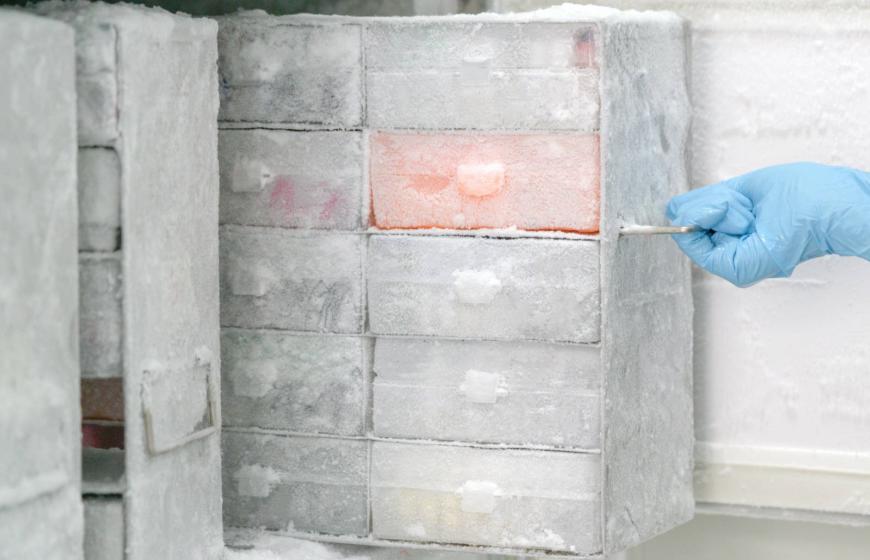Coregas Specialty Gases and Equipment brochure
Download
Multiple clinical applications require storage of biological samples in at temperatures below -40°C. There are two main ways gases help to achieve this: deep freeze units with carbon dioxide cylinders used as backup and cryogenic storage, which requires liquid nitrogen.

Deep freezers use a mechanical freezing system to operate at temperatures between -40 and -86°C, usually with carbon dioxide cylinders kept as backup in case of failure of the mechanical system. Much colder cryogenic storage uses liquid nitrogen to operate at -196°C; it is used by hospitals, clinics and cryobanks for cell and tissue sample storage, and in animal husbandry for bull semen storage.
Almost every hospital has a deep freeze unit for sample storage. The operating temperature is generally -40, -50, -60 or -86°C. To maintain these low temperatures, the freezers have heavy-duty mechanical refrigeration systems with large compressors running from an electrical power supply. They operate just like your freezer at home, but use different refrigerant gases to achieve the low temperatures and require more robust machinery and more precise temperature control systems.
Long-term sample storage relies on the deep freeze temperatures being maintained at all times. Failure is not an option: if the samples warm up they will be permanently damaged. To mitigate against the risk of thawing, two main strategies are employed. Firstly, it is common to replicate the sample storage in another freezer, sometimes even in a different location. Secondly, there is often a backup cooling system coupled to the freezer, which is activated automatically in the event of an electrical power failure preventing the mechanical freezer system from operating. The backup cooling system uses either liquid nitrogen supplied from a storage tank through a liquid nitrogen pipeline or carbon dioxide from cylinders which are permanently on stand-by stored adjacent to the sample freezer.
If liquid nitrogen is used at the hospital site for other applications, it may be economical to direct some of the liquid nitrogen to a deep freeze backup system. This will require installation of appropriate insulated stainless steel piping to transfer the liquid nitrogen from the bulk storage to the freezer gas supply control panel. This can be a viable solution for larger storage banks. However, it is more common and generally more cost effective to use carbon dioxide cylinders for the backup system.
Use of carbon dioxide cylinders for deep freeze backup is very simple. The cylinders are easy to store and take up relatively little space next to the deep freeze. They require very little maintenance and there are no boil-off losses from the cylinders. Cylinder changeovers are infrequent and would only be required after the backup system has been used to cover for a power outage.
The cylinders should be specified to be supplied with a dip tube so that liquid carbon dioxide from within the cylinder can be withdrawn. Some people also refer to this dip tube as a 'siphon'. The liquid carbon dioxide which is stored inside the cylinder will depressurise as it comes out of the cylinder into the freezer, where it will form solid carbon dioxide at -78.5°C. Over time, this powdery solid carbon dioxide sublimes to form a cold gas that will circulate through the freezer to maintain the cold temperatures required to guarantee the integrity of the samples.
The carbon dioxide snow cloud that is produced by a carbon dioxide fire extinguisher cylinder is identical to the operating principle above. Carbon dioxide fire extinguisher cylinders are also fitted with dip tubes.
Several grades of carbon dioxide in cylinders are supplied by Coregas. Many are used for metal fabrication and industrial laser applications. Other grades are used in laboratories for analytical equipment. Carbon dioxide is also used in many food and beverage applications such as chilling and beer or soft drinks dispense. The most appropriate grade to specify for this biological freezer backup system would be Carbon Dioxide Food Grade.

Many hospitals and clinics use liquid nitrogen cryogenic sample storage on site or send samples to a cryobank for off-site storage. The operating temperature of the cryobank is permanently regulated at -196°C due to the physical properties of liquid nitrogen.
Long-term sample storage relies on cryogenic temperatures being maintained at all times. If the samples warm up they will be permanently damaged. Considering that the samples may be precious embryos or semen for fertility clinics, or biopsy tissue samples from oncology wards, it is essential that the samples are preserved with the utmost caution. It is therefore critical to ensure a consistent uninterrupted supply of liquid nitrogen to the storage unit.
If liquid nitrogen is used at the hospital site for other applications, it may be economical to install a bulk liquid nitrogen storage tank outside the hospital in the grounds. In this case, small transportable liquid nitrogen dewars can be filled at the liquid nitrogen storage tank and then rolled back inside to the sample store. Alternatively, liquid nitrogen from the bulk tank can be piped to the sample store using insulated stainless steel piping. If there is no requirement for a bulk storage tank on site, our smaller Microbulk portable liquid nitrogen tanks can be used. They have capacities of 200 or 300 litres, are vacuum-insulated to minimise liquid nitrogen boil off and can be transported inside the hospital or clinic and kept near the sample store.